Going Agile has more or less become the norm these days. As it's almost been 20 years since the release of the Agile manifesto, many teams have already adopted its values and principles. However, that's only one side of the coin - the team side.
Applying Agile on the team level gives results but is often limited to a single team's improved performance. Especially in large businesses, that might turn out to be ineffective if all other organizational structures keep their traditional way of operating. After all, companies are systems and not merely the collection of teams. Or, to use the words of Dr. Russel Ackoff:
"A system is never the sum of its parts. It is the product of the interaction of its parts."
That is why scaling Agile is the path to unlocking the full potential of your company and achieving real business efficiency. In fact, given today's highly volatile business environment, organizations are beginning to see this as a necessary step for their long-term survivability.
What Is Agile at Scale?
Agile at scale refers to the capability of Аgile at the team level while simultaneously applying sustainable principles, practices, and outcomes across various layers of the organization.
Scaling Agile is about taking the Agile mindset with its principles and practices beyond the team level and applying it across the organization. This involves a cultural change and a global transformation of a company toward a more value-focused business environment. The goal is to create a symbiosis between all organizational structures and effectively respond to emerging changes or risks in the market.
Achieving organizational agility is much easier said than done. Companies need to have a well-oiled system in place to bring Agile practices across multiple teams and to the highest portfolio and strategic layers. To do that in practice, many of them typically turn to a specific scaling framework.
Why Do You Need to Implement Agile at Scale?
While applying Agile practices locally was seen as revolutionary just a few years ago, today's volatile business environment calls for scaling agility. Companies need to create transparency in their processes by building connected systems and optimizing their efficiency.
By scaling Agile at the organizational level, companies manage to:
- Bridge the gap between strategy and execution
- Improve team and cross-team collaboration
- Quickly shift direction when necessary
- Increase the predictability of value delivery
- Create superior value for the end customers all the time
Now, let’s sneak peek into some of the most popular scaling Agile frameworks.
What Are the 5 Most Popular Frameworks when Implementing Agile at Scale?
There are no universally accepted frameworks when implementing Agile at scale. Nonetheless, several organizations have successfully enhanced their processes, teams, and cultures by implementing Agile scaling frameworks.
Agile Scaling frameworks are organizational models guiding multiple teams on how to work together to bring agility to the enterprise level. Let’s briefly touch upon some of the most popular frameworks/ methods organizations use to adopt Agile at an organizational level.
1. Kanban Maturity Model
The Kanban Maturity Model (КММ) is a process-level improvement model that promotes agility through the Kanban method. It defines the level of organizational maturity and shows what actionable steps are required toward a successful Kanban implementation at each maturity level. The KMM model helps teams, departments, and entire organizations to gradually advance their Kanban knowledge by moving from one level to another.
2. Scaled Agile Framework (SAFe)
SSAFe is a framework that empowers organizations to adopt the Agile way of working at scale. Based on the Agile principles and values, the framework provides structured guidance on how to plan and manage work better, improve collaboration, and deliver products faster. SAFe incorporates several practices and principles for creating a working culture where the decision-making process and Agile way of thinking are promoted among everyone in the organization.
3. Large-Scale Scrum (LeSS)
The Large-Scale Scrum (LeSS) is a product-development framework that focuses on applying Scrum's principles and practices in the most straightforward manner possible. At its heart, LeSS supports the minimalistic concept (fewer roles, events, management, etc.), and scaling should follow this pattern to drive successful Agile deployment. This method is used by multiple cross-functional teams working together on the same product within a common Sprint.
4. Scrum@Scale (SaS)
Scrum@Scale, as a scaling framework, is a natural extension of the Scrum method. It works around the idea of coordinating multiple teams’ efforts toward achieving common business goals in complex environments while rolling out agility across the entire organization.
5. Spotify Model
The Spotify model represents a work structure the company created to scale its adoption of Agile across the organization. This model stresses creating an environment of enhanced collaboration and transparency across multiple product development teams and improved product delivery process.
The Spotify model is built around a specific structure of Agile product development teams that consists of the following key elements: squads, tribes, chapters, guilds, alliances, and trios.
While there is nothing wrong with investing in a framework that best fits your team and organization, it could turn out to be very cumbersome and expensive in the long run. That's why we would like to introduce you to an alternative way of scaling Agile across the organization - the Kanban way.
7 Fundamental Principles for Practicing Agile at Scale
As professionals, we recognize that there is no universal way to expand Agile frameworks. Still, seven crucial principles should be taken into consideration when practicing Agile at scale. These principles are imperative, as success cannot be achieved without them.
Whether you plan to utilize a framework or implement certain practices, these principles should be regarded as guiding principles for what can be adapted or formalized within your organization.
1. Implementation of clear role definitions and organizational structure modifications.
2. Establishment of a customer-centric organization and fostering of its development.
3. Incorporation of Agile practices and adherence to a consistent cadence.
4. Recognition of the time required for adoption and maturity.
5. Improvements in dependency across the entire organization.
6. Achieving buy-in from both the top-down and bottom-up levels of the organization to ensure actual change.
7. Emphasis on people, Lean principles, and systems thinking.
The Data-Driven and Humane Approach when Implementing Agile at Scale
When applying an Agile scaling framework, there is usually a big focus on following strict guidelines and revolutionizing your processes to make them better. This often contributes to resistance and chaos that many organizations might fail to deal with. As a result, they revert to their old way of operating, abandoning the idea of bringing agility globally.
In contrast, Kanban offers an evolutionary path to agility, where you don't disrupt your current processes and roles. It addresses the human need for respect and focuses on data-driven decision-making.
That's why, to have a stable starting point, you keep what has been working for you so far and then gradually evolve from there through continuous improvement. This is done with the help of Kanban’s practices, such as visualization, limiting work in progress, implementing feedback loops, making policies explicit, and managing flow.
When starting with Kanban, managers believe that those practices are predominantly applicable to the team level to increase efficiency. The reality is that they can be implemented with the same, if not higher, rate of success across the entire organization. With the introduction of multiple Kanban boards, for example, managers can build connected value streams and focus on optimizing the whole rather than only separate local flaws.
The question is, how all of this can be brought to life? Let us show you how you can apply Kanban to scale Agile in practice.
What Are the Key Points when Implementing Agile at Scale with Kanban?
When using Kanban to scale Agile, your primary focus should be figuring out how to create customer value from beginning to end. Then you should connect and visualize this entire process to unhide cross-dependencies and optimization potential in your system.
You also need to establish Kanban systems on all levels to ensure workflow stability and improve predictability. Another critical step is introducing regular cadences to plan and coordinate the release of value within the entire structure.
1. Connecting Strategy to Operations with Interconnected Kanban Boards
Did you know that an estimated 67% of all well-polished strategic initiatives fail due to their poor implementation? Some common reasons for the high failure rate include huge gaps between strategy and operations and a lack of organizational transparency.
Map and Connect all Your Value Streams
That's why the first step to scaling Agility on a global level is to have a highly-refined structure in place, tying up all your value streams together. In practice, this can happen with the introduction of interconnected Kanban boards. You can use them to visualize all the organization segments, going from the highest strategic level down to the team level or vice versa.
For example, you can build a Master Kanban Board or a dedicated workflow within it that represents your company's business objectives. There, your aim should be to visualize your organization's high-level strategic initiatives and regularly revisit them to make sure you are moving in the right direction.

Senior managers can then engage in collaborative discussions and refine and break down those initiatives into a portfolio of separate projects that support the high-level vision. In turn, those projects can be further broken down into smaller deliverables (depending on their size) or directly linked to the specific teams responsible for their execution. To make this entire structure possible, you can use related Kanban boards interlinked based on their hierarchy (ex. Strategy-Portfolio/Program-Project-Team).
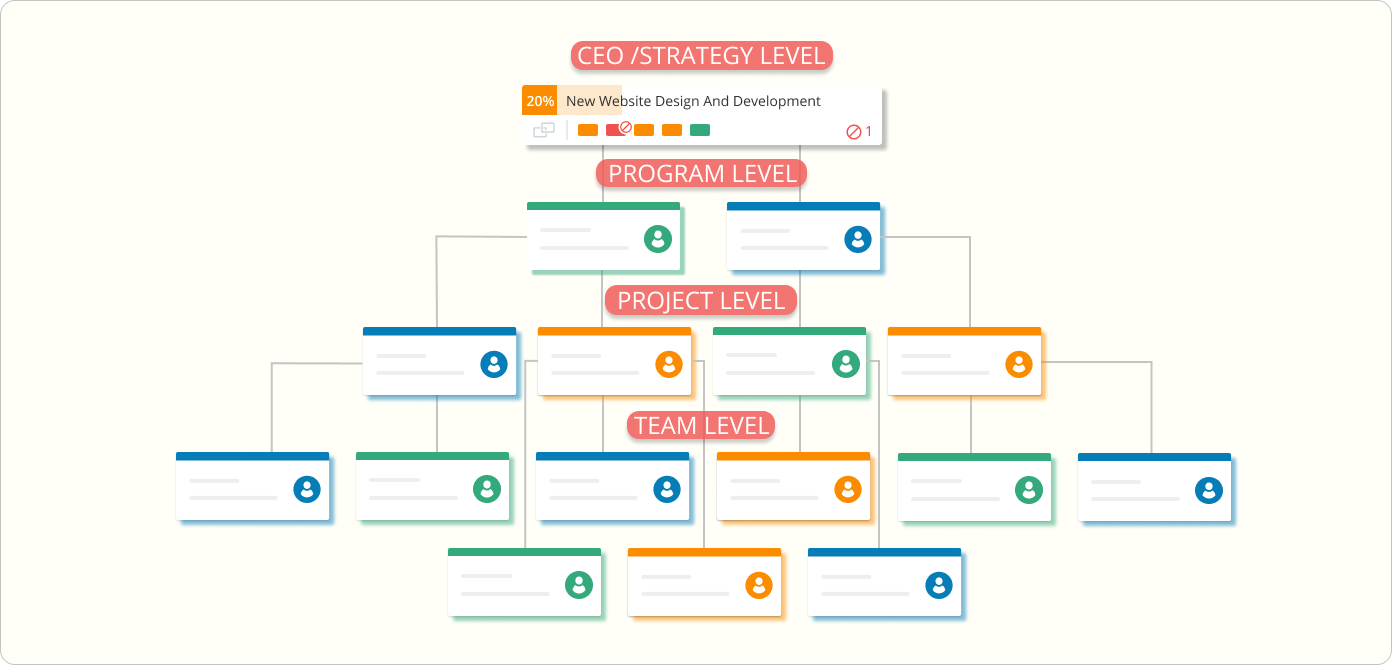
Visualize all Team-Level Workflows
Once you have the initial "coarse-grained" plans on the portfolio/project level, you should progressively refine them. In other words, look to add more details in the course of the project rather than trying to pre-plan everything from the very beginning. Using our platform, we do this inside separate Kanban boards on the team level, where team members visualize their specific workflows.
Here, the idea is to break down the project or its multiple deliverables into the smallest measure of detail - the tasks and then track their flow throughout the process. This is where the team collaboratively determines what to execute next and progressively pulls new work as previous tasks are getting done. As a result, team leaders or managers in Kanban spend their time uncovering bottlenecks and optimizing process efficiency rather than maximizing capacity utilization.
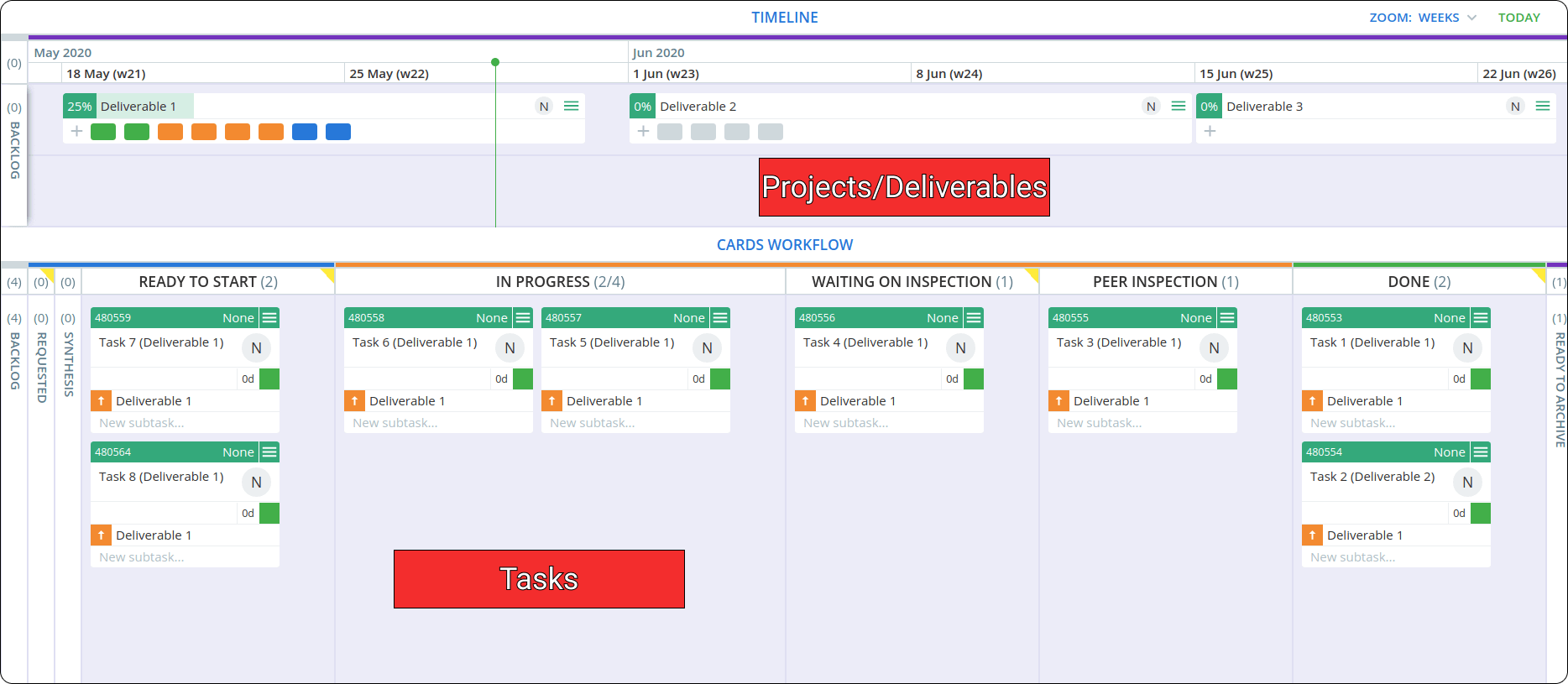
Using this entire structure of interconnected Kanban boards can help you translate your vision into practice and connect high-level objectives to their day-to-day execution. As a result, you will build transparency across the organization and be one step closer to scaling agility.
2. Implementing Agile at Scale with Kanban Systems on All Levels
Transparency alone brings a lot of improvement to daily operations. However, it is not the ending point when scaling Agile. That's because the main purpose of scaled Agile is to create synchronization between all organizational layers so that everybody is working on the right thing at the right time. That's why apart from merely visualizing all work activities, you also need to ensure that there is a Kanban system in place - not just on the team level but across the whole company too.
Limiting WIP on a Global Level
Building a Kanban system on all organizational levels requires a system-thinking approach. To achieve that, one of the first steps is to limit WIP (Work In Progress) on a global level. It means limiting the number of strategic initiatives and projects (it could be a portfolio of products) that are in progress in your organizational system.
This allows senior managers to ensure that what comes from a global position as a top priority will always be worked on by the teams and finished as soon as possible.
Furthermore, you also need to manage your entire organization's flow to transform your operations into a complete value delivery system. Apart from limiting WIP, this entails introducing commitment points, blocking work on a global level (in case larger issues appear), and measuring metrics such as lead and cycle time.
Introducing Commitment Points
Applying commitment points on a project/portfolio level is an excellent practice for managing global flow. On the Master Kanban board, you can visualize the validation process of a project and the point in the system when it's ready for execution by the teams. This creates a shared understanding of how a project goes from concept to fruition and helps you organize its final customer delivery.
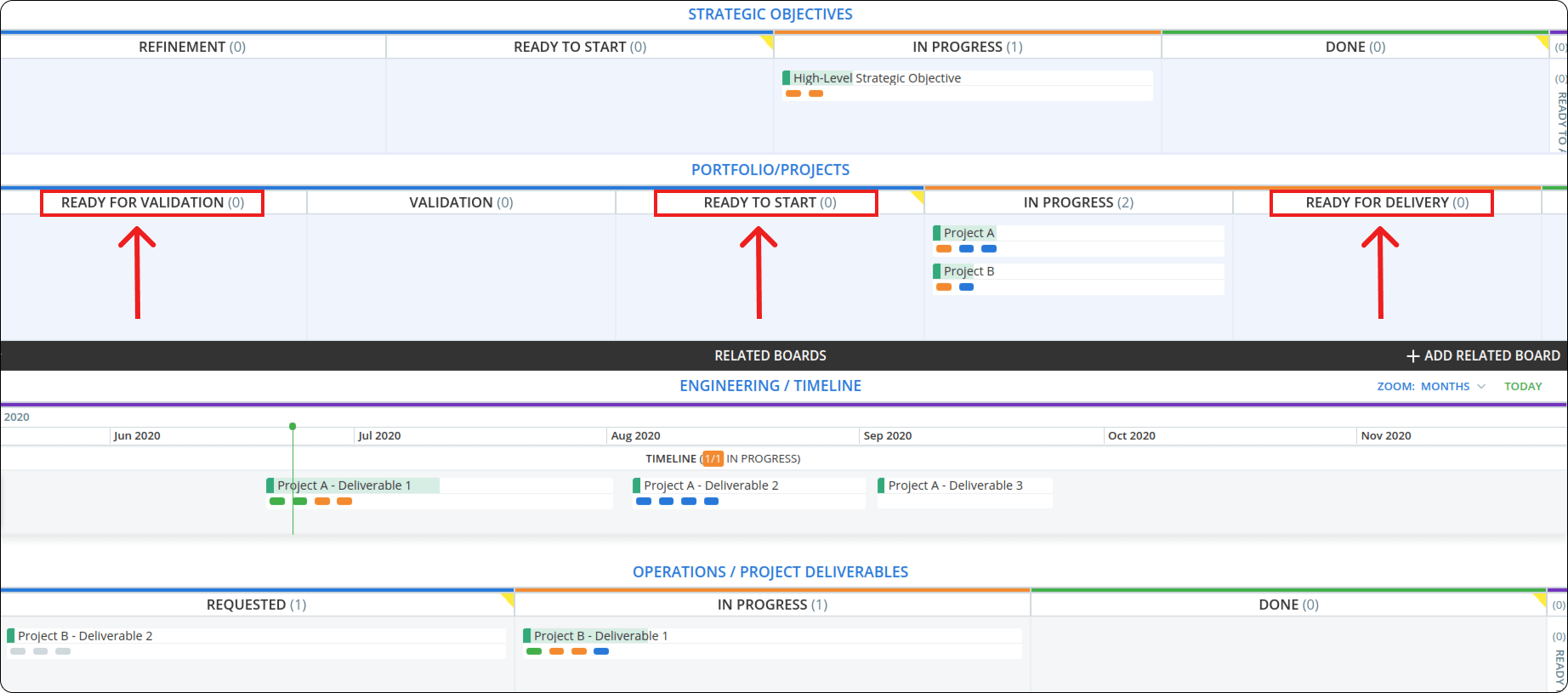
Tracking and Measuring Metrics
Tracking metrics is another fundamental part of building a Kanban system.
Measuring lead, cycle time, and throughput on a strategic or project level (apart from just separate work items on the team level) gives you the tools to analyze your system as a whole and look for ways to improve it.
With the introduction of Monte Carlo simulations, for example, you can take a probabilistic planning approach to projects or high-level strategic initiatives. Instead of estimating them based on your gut feeling, you will be able to forecast your delivery dates with greater certainty.
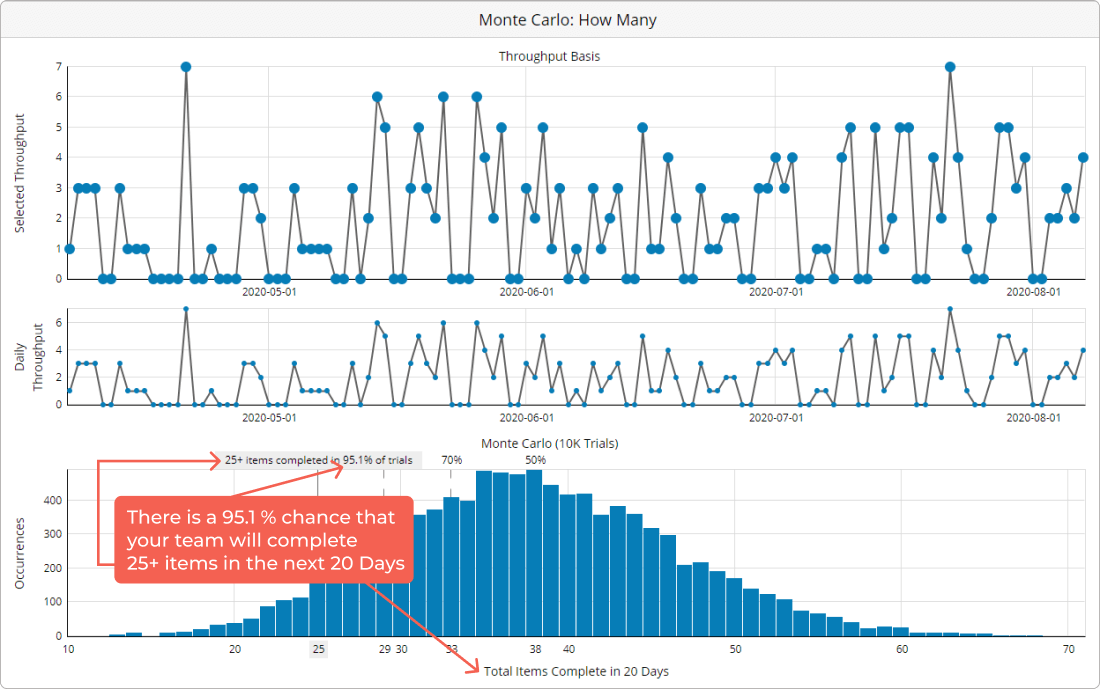
Building connected Kanban systems will contribute to the creation of Flow across your entire organizational structure. This will result in the delivery of superior products or services to the market and flexibility to satisfy your changing customer's needs.
3. Coordinating and Planning Work
Another important point when scaling Agile across the organization is coordinating and planning the work on a global level. The way to do this with Kanban is through the application of regular Kanban cadences.
In general, those are meetings for aligning business communication that can help you regularly plan, review, and sync work progress to retain agility and adapt to changes whenever necessary. The Kanban cadences, just like Kanban's practices, are applicable both on the team and strategic levels in the organization.
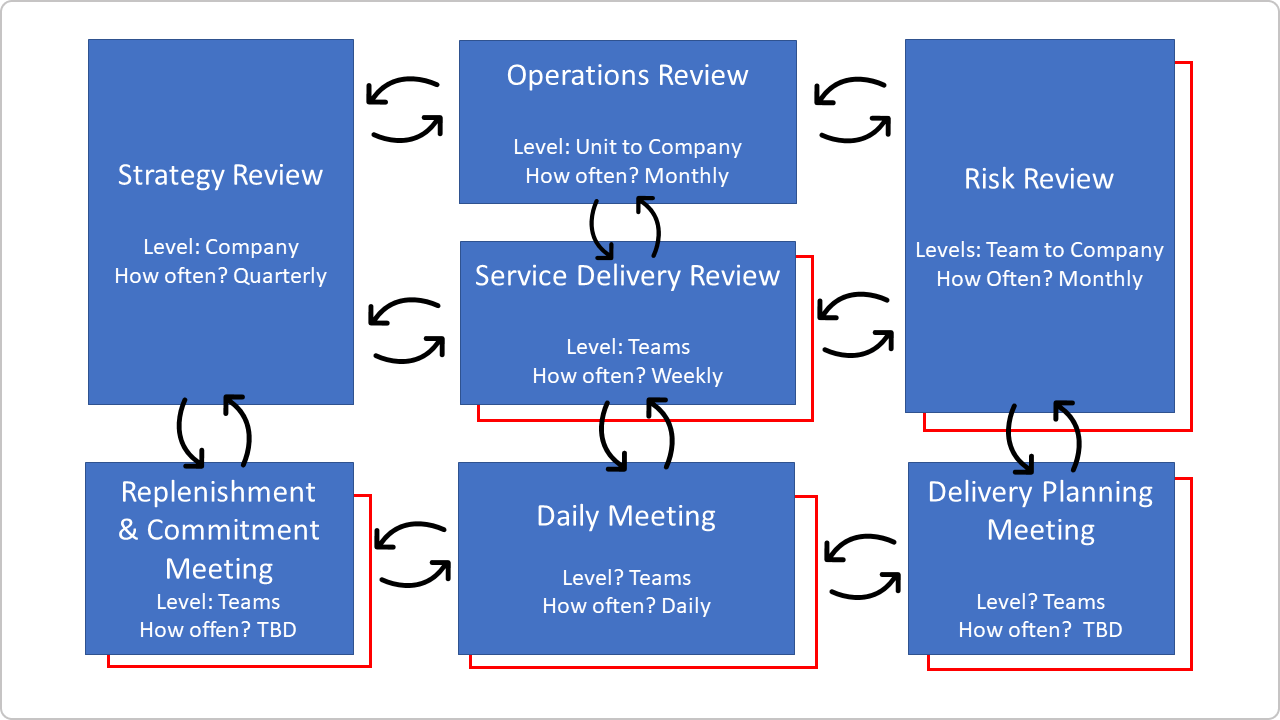 Kanban cadences
Kanban cadences
Project Stand-up Meetings
For example, the Daily meeting is very popular on the team level, where team members stand up in front of a board and sync their progress. This cadence can be scaled up so that every team sends a delegate to a broader project stand-up meeting (involving multiple teams) where the entire project progress is discussed. The idea here is to sync progress on a higher level and discuss dependencies between teams and visualize them on the multiple team Kanban boards.
Operations Review
The Operations Review, on the other hand, is the cadence that takes a holistic view of the performance of all internal teams inside the organization. This is the time when team leaders, and functional or mid-level managers come together to look for improvements in the organizational operations as a whole and discuss optimizations in the entire flow of value throughout the system.
Strategy Review Cadence
In addition to that, you can engage in regular Strategy Review cadences at the top level of the organization. There, the goal is to align progress toward meeting strategic goals as well as plan new ones. Our managerial staff at Businessmap, for example, meets every week around the Management/Strategic Kanban board to discuss the progress of the defined strategic initiatives. They aim to make sure that we are still doing the right things and, if necessary, adapt to changes and quickly shift the direction of the entire company.
The Kanban cadences can keep you aligned towards the most critical work that you need to do now and the bigger picture inside your company. As a result, you will improve collaboration between all organizational layers and more frequently deliver value to your end customers.
So, Where to Begin with Agile at Scale?
Whether to promptly respond to fast-changing market conditions, gain a completive edge, change organizational behavior, or drive digital transformation, agility can help you build that long-term resilience. You can start with what many Agile companies do - use helpful techniques on your path to scaling Agile, or you can invent your custom holistic approach, there is no right or wrong approach. Start with the people and consider your specific needs.
Agile at Scale Frequently Asked Questions (FAQ)
What are some common challenges organizations face when implementing Agile at scale?
Some common challenges organizations face when implementing Agile at scale include:
1. Resistance to change: Employees may resist change and need help to adapt to new roles, responsibilities, and ways of working.
2. Lack of collaboration: Agile requires collaboration and communication between teams, departments, and stakeholders. Without a culture of collaboration, the implementation of Agile may fail.
3. Inconsistent adoption: Different teams may adopt Agile at different speeds or with different levels of commitment, leading to inconsistency in practice and results.
4. Scaling Agile practices: Implementing Agile at scale requires significant coordination and planning to ensure that all teams are aligned and working towards the same goals.
How can Agile principles be adapted and scaled to meet the needs of large, complex organizations with multiple teams and stakeholders?
Agile principles can be adapted and scaled to meet the needs of large, complex organizations with multiple teams and stakeholders by implementing the following strategies:
1. Establish a shared vision and goals: Establishing a shared vision and goals across the organization is important to ensure that all teams work towards the same objectives.
2. Divide work into manageable chunks: Break down larger projects into smaller, more manageable pieces of work that individual teams can complete.
3. Implement a clear governance structure: Establish a clear governance structure to manage the flow of work, decision-making, and communication across teams and stakeholders.
4. Emphasize collaboration and communication: Encourage collaboration and communication between teams and stakeholders to ensure that everyone is aligned on project objectives and progress.
What role do leadership and organizational culture play in successfully implementing Agile at scale?
Leadership and organizational culture are crucial in successfully implementing Agile at scale. Leaders must champion the Agile mindset and create a culture of continuous improvement, collaboration, and flexibility. They must establish clear goals and objectives, prioritize customer satisfaction, and empower their teams to make decisions and take ownership.
Additionally, leaders should encourage open communication, transparency, and trust to foster a culture of innovation and learning. Organizations with a supportive and adaptable culture are better equipped to embrace Agile principles and practices and effectively scale their Agile initiatives.
We offer the most flexible software platform
for outcome-driven enterprise agility.





